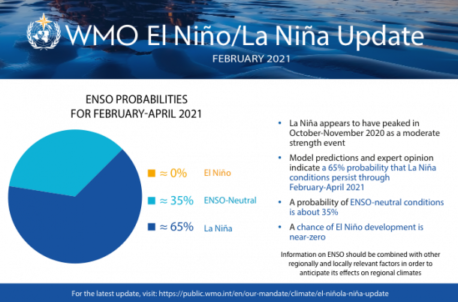According to the latest El Niño/La Niña phenomenon recently released by the World Meteorological Organization, the La Niña event from 2020 to 2021 has peaked from October to November 2020, which is a moderate-intensity event.
Although the peak period has passed, its impact on temperature, precipitation and storm patterns continues.
Despite the impact of the overall cooling of the La Niña event, land temperatures are expected to remain above normal in most parts of the world from February to April 2021.
The agency noted that the La Niña phenomenon has a temporary global cooling effect, but it has not prevented 2020 from becoming one of the three warmest years on record.
The impact of La Niña and El Niño on global average temperatures is usually the strongest in the second year after the event, and it remains to be seen to what extent the La Niña event can affect global temperature in 2021.
World Meteorological Organization Secretary-General Taras said that El Niño and La Niña are the main drivers of the earth’s climate system, but all naturally occurring climate events now occur in the context of human-induced climate change, which is raising global temperatures, exacerbating extreme weather, and affecting Seasonal rainfall patterns and complicate disaster prevention and management.
Taras also pointed out that thanks to the ability to predict La Niña and El Niño events in advance, the World Meteorological Organization system can strengthen its support to governments, the United Nations and stakeholders in climate-sensitive sectors, thus mobilizing people to be prepared and save lives.
La Niña is a significant cooling of ocean temperatures in the central and eastern equatorial Pacific Oceans, accompanied by changes in tropical atmospheric circulations (i.e. wind, pressure and rainfall), which usually affect the weather and climate in contrast to the El Niño phenomenon.



